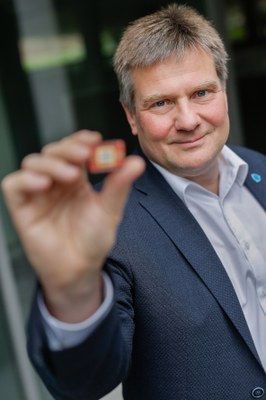Air quality monitoring, microbe analysis, or new technologies for ultrasound imaging: micro- and nanotechnology have applications in many fields. Integrating this technology into tiny systems that tackle tomorrow’s challenges is the mission of LIMNI, the latest KU Leuven Institute.

Photo: KU Leuven - Rob Stevens
The KU Leuven Institute for Micro- and Nanoscale Integration (LIMNI) brings together researchers from various disciplines who work at very small length scales, explains founding member Michael Kraft from the Department of Electrical Engineering (ESAT). “To give you an idea: if you take a single hair and roll it between two fingers, you get a diameter of between 50 and 100 micrometres. And if you’re working at nanoscale, you have to divide that by a factor of more than a thousand, as one nanometre equals one-billionth of a metre.”
Integrated systems
KU Leuven hosts many researchers working at this scale, with disciplines ranging from mechanical, electrical, materials and bioscience engineering to physics, chemistry, and medical sciences, to name just a few examples. Michael Kraft: “Many of these researchers are leaders in their field, but if we want to address tomorrow’s challenges, all of us must share and integrate our knowledge.”
The KU Leuven Institute will focus on integrating micro- and nanoscale technology into larger systems. Examples include the use of porous, three-dimensional structures known as metal-organic frameworks (MOFs), which act as a kind of sponge for specific molecules in air. This quality makes them very useful for air quality monitoring. “Just think of the ‘electronic nose’ for pesticides and nerve gas that was developed by my colleague Rob Ameloot. If we combine his expertise with my work on microbalances, the measuring of added or removed mass, we can monitor air quality even more precisely in the future.”
Micro- and nanotechnology have potential medical applications as well. “This is not my expertise, of course, as I’m an electrical engineer. But we could try to combine microbalances and research on antibodies to measure virus concentrations, capture and analyse microbes with microfluidic chips, or use miniaturised ultrasound technology to create novel and cheaper methods for ultrasound imaging. The possibilities are endless.”
Red pin on the map
Before LIMNI became a KU Leuven Institute, several members were already collaborating across disciplinary boundaries. Becoming an Institute, however, creates new opportunities, says Michael Kraft. “Five years ago, KU Leuven opened the Leuven NanoCentre, so we already have labs where researchers can work together. Our building is a big black box, and now we need to give it a ‘face’. We want to become a place where researchers come to meet and collaborate systematically, and where we can host renowned speakers.”
“When you compare us with similar institutes in Europe and elsewhere in the world, you realise that KU Leuven has yet to become a red pin on the map in this field, even though we already have the expertise and the infrastructure. As a KU Leuven Institute, we will get the visibility we need to set up new collaborations and attract talented new researchers. We’ll also be able to deepen our collaboration with KU Leuven partners such as Imec, NERF, VITO, Flanders Make, and VIB.”
Michael Kraft founded LIMNI together with Frederik Ceyssens and Rob Ameloot (both from the Department of Microbial and Molecular Systems), and Steven De Feyter from the Department of Chemistry.
This article was first published on 16 December by KU Leuven.




 A unique international forum for public research organisations and companies to connect their external engagement with strategic interests around their R&D system.
A unique international forum for public research organisations and companies to connect their external engagement with strategic interests around their R&D system.